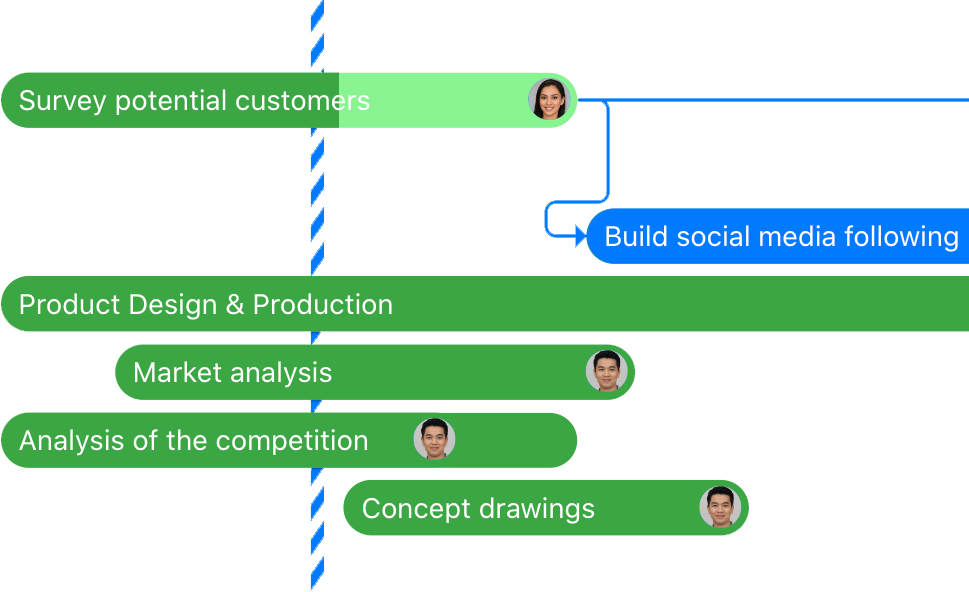How to Create True Project Visibility: 6 Helpful Strategies
Ever wondered why projects fail?

Projects could fail because the team has no clear project visibility, including team goals and milestones. They see only the parts they need to work on and do not see the overall project tasks. If the team commits to the project, their technical scope and marketing case should be well defined.
Moreover, the project manager must establish a harmonious work environment by detecting issues before they escalate. A team will function better and be happy to take up task ownership in a healthier work atmosphere. But how will the project managers achieve it if the team’s work is not visible?
The solution to creating an accountability and accuracy culture in the workplace is thus project visibility.
What Does Project Visibility Mean?
If the project frequently deviates despite all efforts to keep it on track, it might be due to a lack of project visibility. Project visibility essentially bridges the gap between the various organizational levels and stakeholders and directly impacts corporate success.

When the words ‘visibility and project’ are combined, it signifies that the whole team working on the project can see each project’s task as the team member works on it. The scrutiny enables them to know the project’s status at any point in time and know what their next move should be to affect its success. Project visibility helps timely detection of potential risks and enables the team to be task accountable.
But is such scrutiny necessary?
It sure is because the project’s performance depends on it as it guides the team to align project goals to meet stakeholder requirements. Project visibility requires excellent team communication and collaboration.
The team analyzes resources critical for project visibility like scorecards, real-time reports, metric tiles, and portfolio dashboards to generate new ideas.
The project visibility plan comprises four components. They are:
1. Project Goals
It is Monday, and you plan to be extra productive during the week. But mid-week, something comes up, and you get waylaid. It could be a movie you waited months to watch and is now available or an impromptu outing that took much of your time – most of us can relate to such a scenario. One excellent way to stop yourself from continuing to lag in the completion of daily and weekly tasks is micro-scheduling.
Time is precious; once gone, it is lost forever, and there is also the burden of finishing the work. Use micro-scheduling, the latest productive trend, to divide your day into convenient chunks of 5 to 15 minutes and allot the tasks you are to perform during that time. The tasks could range from checking emails and scheduling appointments to managing finances.
Often referred to as an extreme trend, it must include your morning routine, lunch, family time, recreation, exercise routines, and everything else you would like to squeeze into your schedule for the day. Encourage the workforce to do the same so that you can complete tasks on schedule.
2. Visual Status Reporting
Projects involve several reports and colossal data. It could be demanding on the workforce and worthless to the stakeholders. Understanding reports with numerous figures can be overwhelming, but visual data is easy to comprehend. Moreover, modern data visualization technology combines dynamic graphics with real-time analytics to provide sharing options that reduce the burden on the workforce in generating them.

When an organization streamlines its reports through visualization and easy distribution, the various project processes become efficient and affect quick execution. Because the customized data dashboard makes it easy for stakeholders and the team members to quickly check and understand only the data they require without going through the entire report. Visual status reporting thus enables businesses to become proactive data users and spend less time doing so.
Finally, the workforce will not need extensive training, nor will the organization need to spend much on installing software or hiring IT personnel. The need is to construct a dashboard for the workforce to use and maintain it up to date with the project’s current state. Allow the team to change the status of their work using editing access.
3. Individual Team Members’ Responsibilities
Careful and meticulous planning and a talented and collaborative project are essential to project success. For progress, the project must have team members in key positions, and their tasks must be clearly defined. The entire workforce could have one of the following roles:
- Project Manager
- Project Team Member
- Project Sponsor
- Executive Sponsor
- Business Analyst
The most critical project personnel is the project manager, who delegates the project tasks to each team member depending on their talents. The project manager must be clear in his or her instructions concerning each individual responsibility towards the project and expected collaborative team results. The most effective way of assigning responsibilities would be to create a dashboard and display each workforce member’s duties for all to see.
4. Any Possible Future Risk
A project evolves in phases, and large projects involve large teams, which makes it easy to get out of sync. Someone in the group may notice the risk but only when faced with the issue and may even find a solution to fix such problems. Although such a fix can help, waiting for an escalation to take action can slow down the project.

It thus becomes necessary to know the risks in advance and alert the team concerning their occurrence and the situation in which they could occur. The team will be watchful in detecting the threats that could alter the course of the project and work to reduce or render the risk powerless by taking immediate action.
Project visibility helps in informing the unknown to the entire workforce through prompt updates; the team becomes vigilant as they have the necessary information concerning the risk and know their responsibilities or the role they must play in such situations.
6 Ways to Create True Project Visibility Across Your Team
Thus, the lack of project visibility is the first reason for project failure. But the challenges don’t end with that. Poor project execution can lead to a loss of reputation for the organization and the entire project workforce, especially the project manager.
We have 6 ways to help create truer project visibility across the team:
1. Develop a Project Communication Plan
Project reports don’t just happen, nor are they the outcome of a stern manager who constantly commands his or her team to provide them. Accurate and excellent reports are possible only by the efficiency of the workforce. The project manager’s transparency and belief in the team’s ability encourage the crew to deliver the desired results, and a project communication plan helps achieve that.

Maximize your team's efficiency with a project communication plan.
Sign up for free today!
A project communication plan guides the project’s hierarchy to pass on critical information to the workforce and stakeholders during the project’s lifetime. It helps decide on two things: whom to share the information with to effect maximum positive project outcomes and when. The project communication plan also indicates to the stakeholder and team members what updates they can expect and how they will receive them.
The workforce can refer to communication strategies whenever they need information. The feedback is especially effective in facilitating the rectification of errors and improvisation as it gives the deserving candidate the much-needed pat on the back to help him continue to work well.
2. Create and Send Regular Project Status Reports
Creation and regular dispatch of project status report update the stakeholders on the project’s progress. These reports are easy to generate and are highly effective in correcting the project’s status to the team, enabling them to undertake corrective measures whenever needed.

The frequency of creating and sending project status reports depends on the project itself. Monthly reports work well for a specific project, but some other projects require weekly status reports.
What is the use of doing all project-related tasks meticulously only to know at the end of the project’s timeline that you are completely off track? Suppose there was a system of creating and sending project status reports in place all would have access to the information concerning the project’s progress, and such falling-outs could be eliminated. As a project report summarizes all that has happened in the month or week, the stakeholders can appreciate that the project has not deviated from the original plan.
3. Include Your Client
The success of a business depends on how well it can retain and manage its clients. Through one of the tactics above, project visibility is critical in encouraging clients to submit input that can enhance the product or service.

Customers will extend their loyalty only when their needs are met. Thus, they need to be acquainted with their problem statements and offer the right before they look for alternatives elsewhere. The organization can offer the clients the practical methodology to integrate daily workflows to enable the client to get better value from the product or service.
Project visibility plans include client management that considers the customer’s demands, predicts the consequences if they are not met, and allocates resources to handle the issues. It also passes on vital information concerning the change in leadership or potential risks that cause delays to prepare the clients for unforeseen delays in the project.
4. Hold Weekly Team Meetings
A project meeting’s objective is to reach decisions that result in finished projects that satisfy their specifications and goals on time and on budget. It is held at regular periods during the project’s lifespan to ensure that everyone who has a stake in the project involves themselves effectively.

Project managers must establish a profile as effective moderators of project meetings, for a well-planned meeting may guarantee that the meeting’s objectives are met. Aim for the fewest participants possible while still reaching project goals. Attendance and participation may suffer if an appointment is extended beyond what was initially planned. Starting a project meeting on time demonstrates leadership and respect for those who have taken time out of their hectic schedules to attend.
A set finish time allows participants to proceed through the agenda more quickly. Great project managers are confident in their ability to take notes gracefully on digressions, assure follow-up participants, and restore everyone’s focus to the agenda.
5. Leverage Task Management Software
The management may forget, postpone, or wrongly delegate crucial tasks if all the information is not easily visible in one place. That could involve wasting productive time and inefficient task performance, leading to project failure.

A task management software tool like Zenkit can help streamline processes. It enables you to organize your day in such a manner to help convert, not the most crucial task of the day, by using intelligent features like –assigned to me, today, favourite, etc.
Stop piling work in your head, for you could forget to do some of it. Instead, load it onto the Zenkit inbox and prioritize and organize each task using the abovementioned innovative feature. The feature offers perfect visibility to help you know when and how to execute the necessary functions, share, collaborate or invite comments using the @mention features. Set due dates and deadlines and receive an alert well before time to enable timely completion of project tasks.
6. Keep Your Work in One Place
Storing the data in one place helps watch real-time movement to control impediments, and potential risks inform stakeholders with regular updates and aid effective decision-making.
Every project has its own complex system, with its own dependencies, needs, documentation, approval processes, and many other processes. Project management is more concerned with process optimization, value delivery, and efficiency. To obtain high-level project visibility, you must first centralize all project-related information.
Tracking your work in one location also implies controlling your entire company’s work in the same system. In this manner, strategy and execution will be brought together under one roof to provide a new form of visibility. Making process policies clear by visualizing them is one of the primary strategies in Kanban. Project visibility aims to provide all stakeholders with real-time information at a glance. The software automatically changes work items’ status and project completion rate.
Final Thoughts
When your best efforts fail, it is time to take stock of the situation. A project visibility plan that outlines project goals with micro scheduling, presents visual status reports, delegates and communicates individual and collaborative responsibilities to the team, and oversees potential risks should keep your project on track. If your system does this, utilize the ideas in this article to generate proper project visibility to assure future project completions.
About the Author:
Dhruv Mehta is a Digital Marketing Professional who works as a brand consultant and provides solutions in the digital era. In his free time, he loves to write about Marketing, SaaS & Workplace Insights. Follow him on Twitter or connect with him via LinkedIn.
FREE 20 MIN. CONSULTATION WITH A PROJECT MANAGEMENT EXPERT
Wanna see how to simplify your workflow with Zenkit in less than a day?
Book a Live Demo